




 |
 |
 |
 |
 |
DEVELOPMENT |
ONLINE
PROJECTS |
|||||
| Hotplate : Tools & Qualities for encaustic art | |
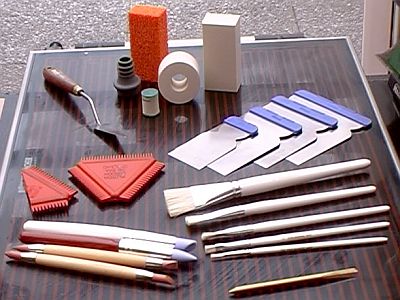 |
Working directly onto a substrate that is under-heated by a hotplate can be an immensely creative experience. Read on below to discover a few pointers to simple tools that are useful as a starting point. Once you start then your own creative juices will flow naturally. |
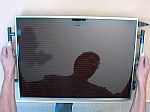 |
This is a hotplate. This particular one, the A2+ Ultimate Hotplate as it is known, has a toughened glass surface, nice carrying handles, a thermostat that works accurately and can be used all day long ( and all night too if you wish!) There are other sizes and types to be had, but we are using this model for the majority of work shown on this site. |
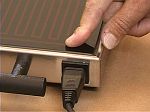 |
Well, you have to plug it in to a power outlet - only available in 220-240 volts for the European market at this time. |
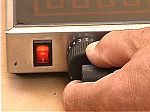 |
The red button switches on and off - always safest to switch off rather than leave any heated electrical tools unattended though! The round knob is the temperature selection dial attached to the thermostatic control 0 - 12 zero being cool and twelve being hot. Normal work is usually between 6 & 8. |
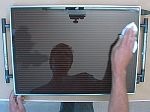 |
Cleaning
is pretty easy. Initially use a tissue whilst the hotplate is working and
warm. Then for a more complete cleaning melt on some clear wax - even a
candle is OK - and wash the glass off by wiping with fresh tissue until
no further dirt is evident. |
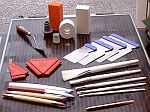 |
There
are numerous tools that can help work the wax once on the card or other
substrate being used on top of the hotplate. On this page see a few of
the encaustic manipulators that are easy to find around the world. |
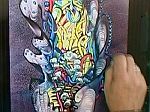 |
Direct application with the wax colour is obviously one way of getting the wax onto the substrate - here onto card which is the "standard" substrate used on this whole web section for hotplate work unless otherwise stated. The crayoned wax melts immediately on contact with the heated card surface. Once applied it can be taken as finished or worked further with a plethora of potential tools. |
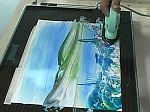 |
Strangely it might seem, the iron can still be useful even on top of the already heated plate. Think of it as a large metal spatula or palette knife tool. The metallic surface and edges offer unique shapes and a particular and hard feel to the resulting marks. Do not underestimate its continued uses in this field of hotplate exploration. |
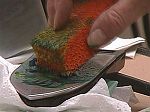 |
The iron itself can be converted into a mini-hotplate and then proves very useful as a working source palette. Wax colour is melted onto the upturned iron where it can be mixed then used to load a sponge or any other tools that will work this way - e.g. tissue, cloth, brushes, etc. |
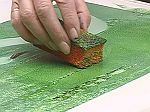 |
Sponges come in a variety of forms and textures, some being very absorbent whilst others are more rubber like and better suited to pushing and shaping the molten wax colours. This orange sponge is being used to apply foliage forms onto a card already coated with wax colour. Other colours can be mixed in too. |
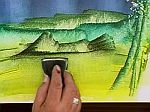 |
The various textures of sponge offer differing types of mark, some being smooth whilst others are visually textured. Here, the edge of the sponge is being used to push the wax colour upwards into a line. Tree trunks, horizons, abstract and formed object, so many uses. |
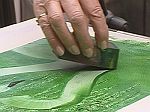 |
The "white block" is one of the more composite rubbery types of sponge and is used here to push the wax aside, creating and clearing the main internal body of the desired object or subject. These sponges often come in different forms; oblong, round, ringed, cylindrical, etc... |
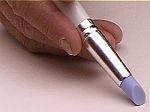 |
Put a rubber type tip on a wooden handle and instead of a brush you have a tool the can shape, move and texture wax colour that is molten. Of course it is equally useful for application of the wax colours that can be sources off the upturned iron or another portion of the hotplate you are using. Also good for mixing colour that is on the working card (or other substrate). See Scrapy Wax Movers |
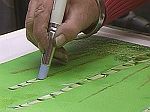 |
Clever consideration of the shape of this tool makes it ideal for these bamboo images, but there are really no boundaries to the potentials. Other shapes exist, so chisel, round and quill forms are all available (to name just a few). |
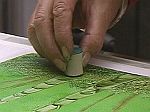 |
Back to the white block sponge, and another method for the similar bamboo image. Circles, partial arcs, free-hand lines and shapes. Lots of opportunities to find uses for this type of shapes tool. |
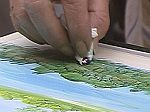 |
Common tissue is a favorite. It can be used to apply colour, smear or remove existing colour, blend, texture, insert, extend, shade, pattern and so on. Here it is being used in a fairly tight bunched form, about the size of a finger tip, to dab in and add extra shading, colour and texture to a row of trees ... |
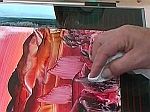 |
... whilst here the tissue is wrapped around a finger to enable careful pushing of the molten wax colour into forms that suit the fantasy landscape being created. |
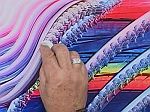 |
The tissue is still wrapped around the finger in this example and has been dragged through the molten waxed colour to create a set of "clean" wide lines. The same line path is then gone over, but this time by tapping the finger on and off as it travels along the length of the line. Wonderful patters arise. |
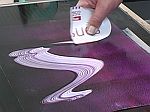 |
A piece of torn card (this one from the top of the tissue box) can provide a multitude of potential marks. The serrations on the edge of this piece produce a marvelous combed effect, allowing small streams of the wax colour to pass through. Any card can be torn on a straight edge to give a more random version of this effect. Similar to "Malachite" stone in its expression. |
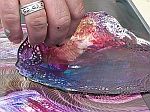 |
A "doilies" is used traditionally on a plate underneath a cake to present it in a pretty and fancy manner. The lacy paper design can offer wonderful trailing marks when used on top of a generously waxed card and then dragged with a shaky hand motion or simply uplifted. Plastics, films, foils, all offer their own particular visual flavors. |
 |
Rubber stamps are exciting to explore when used as "block brushes". The rubber is not damaged at all by the moderate heat of the molten wax, so can safely and continuously be used. Each edge of the stamp can yield a differing mark shape. These are great for texturing into abstract and fantasy works. In larger paintings they can be used to add interest too. |
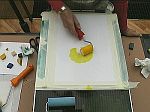 |
Sponge rollers are used in home decoration for those small or difficult areas. They adapt wonderfully to the world of encaustic art and enable smooth graded backgrounds to be achieved fairly easily. You need to understand that to keep a roller clean and "in one colour" you must avoid rolling over any other colour. So areas of single unblended colour need to be applied first with a colour specific roller. |
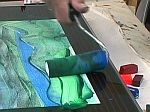 |
A larger 4" (100mm) sponge roller is being used here to create an edge mark. The roller is slightly angled so that all the pressure is placed on the outer edge (away from the handle). As the rolling occurs this heavy pressure helps create a defined line form. Rollers are "loaded" by rolling back and forth through molten wax colour already melted onto a free area of the hotplate. This could also be done on an area of the painting card that will be over-painted later with a darker tone. |
 |
Sequential marks have been created here by pressing down firmly on the inner handle end then lift, rotate, place, lift rotate, place, etc until the desired pattern has been formed. A dry roller will remove colour. A loaded roller will place new colour or add blending to existing colour. |
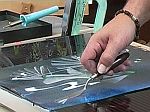 |
A regular painters palette knife is employed in the molten encaustic wax just as if it were any other viscous paint medium. The metal blade will retain enough heat to work the wax in a very fluid manner. Fresh colour can be crayon melted into place then worked over with the knife, or the upturned iron can be used as a source palette. Simple place and lift operation will create "stamps" of the knife shape. |
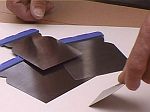 |
Japanese knives are thin flexible metal tools, often used to apply filler in home decoration. These are available in specialist DIY store. They offer a great tool for application of the wax colours; source these from the upturned iron. Ensure there is some insulative material on the handle area or they will be too hot to hold! |
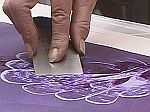 |
Here the metal blade end is used to swirl through the wax coated card, creating shapes and edges; these are mussel shells. Note: because only the end is in use the heat is low enough to hold the actual metal blade which offers the user greater control. |
 |
... and finally, on this page at least, there is direct combination of heated blown air from a hair dryer. The waxed card is being blown in many distinct places to form a collection of flower heads. What other tools are already springing to mind? |
|